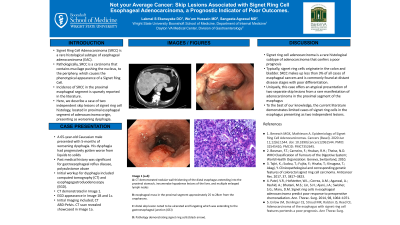Back


Poster Session D - Tuesday Morning
Category: Esophagus
D0225 - Not Your Average Cancer: Skip Lesions Associated With Signet Ring Cell Esophageal Adenocarcinoma, a Prognostic Indicator of Poor Outcomes
Tuesday, October 25, 2022
10:00 AM – 12:00 PM ET
Location: Crown Ballroom

Has Audio

Lakmal S. Ekanayake, DO
Wright State University Boonshoft School of Medicine
Centerville, OH
Presenting Author(s)
Lakmal S. Ekanayake, DO1, We'am Hussain, MD2, Sangeeta Agrawal, MD3
1Wright State University Boonshoft School of Medicine, Centerville, OH; 2Wright State University Boonshoft School of Medicine, Dayton, OH; 3Dayton VA Medical Center, Dayton, OH
Introduction: Signet Ring Cell Adenocarcinoma (SRCC) is a rare histological subtype of esophageal adenocarcinoma (EAC). Incidence of SRCC in the proximal esophageal segment is sparsely reported in the literature. Here, we describe a case of two independent skip lesions of signet ring cell histology, located in proximal esophageal segment of adenocarcinoma origin, presenting as worsening dysphagia.
Case Description/Methods: A 65-year-old Caucasian male presented with 5-months of worsening dysphagia. His dysphagia had progressively gotten worse from liquids to solids. Past medical history was significant for gastroesophageal reflux disease, polysubstance abuse. Initial workup for dysphagia included computed tomography (CT) and esophagogastroduodenoscopy (EGD).
CT demonstrated nodular wall thickening of the distal esophagus extending into the proximal stomach, innumerable hypodense lesions of the liver, and multiple enlarged lymph nodes. EGD showcased an esophageal mass in the proximal segment approximately 25 to 28cm from the oropharynx and a distal skip lesion noted to be ulcerated and fungating which was extending to the gastroesophageal junction (GEJ) Notably, through endoscopy, no gross abnormalities was detected between the two lesions. Biopsy of both lesions revealed well-differentiated invasive adenocarcinoma with signet ring cells. The patient deferred treatment and palliative care measures were started. The final diagnosis was metastatic signet ring cell carcinoma (SRCC) in the proximal esophageal segment. The patient passed away seven days after diagnosis
Discussion: Signet ring cell adenocarcinoma is a rare histological subtype of adenocarcinoma that confers a poor prognosis. Typically, signet ring cells originate in the colon and bladder. SRCC makes up less than 3% of all cases of esophageal cancers and is commonly found at distant disease stages with poor differentiation. Uniquely, this case offers an atypical presentation of two separate skip lesions from a rare manifestation of adenocarcinoma in the proximal segment of the esophagus. To the best of our knowledge, the current literature demonstrates limited cases of signet ring cells in the esophagus presenting as two independent lesion
Disclosures:
Lakmal S. Ekanayake, DO1, We'am Hussain, MD2, Sangeeta Agrawal, MD3. D0225 - Not Your Average Cancer: Skip Lesions Associated With Signet Ring Cell Esophageal Adenocarcinoma, a Prognostic Indicator of Poor Outcomes, ACG 2022 Annual Scientific Meeting Abstracts. Charlotte, NC: American College of Gastroenterology.
1Wright State University Boonshoft School of Medicine, Centerville, OH; 2Wright State University Boonshoft School of Medicine, Dayton, OH; 3Dayton VA Medical Center, Dayton, OH
Introduction: Signet Ring Cell Adenocarcinoma (SRCC) is a rare histological subtype of esophageal adenocarcinoma (EAC). Incidence of SRCC in the proximal esophageal segment is sparsely reported in the literature. Here, we describe a case of two independent skip lesions of signet ring cell histology, located in proximal esophageal segment of adenocarcinoma origin, presenting as worsening dysphagia.
Case Description/Methods: A 65-year-old Caucasian male presented with 5-months of worsening dysphagia. His dysphagia had progressively gotten worse from liquids to solids. Past medical history was significant for gastroesophageal reflux disease, polysubstance abuse. Initial workup for dysphagia included computed tomography (CT) and esophagogastroduodenoscopy (EGD).
CT demonstrated nodular wall thickening of the distal esophagus extending into the proximal stomach, innumerable hypodense lesions of the liver, and multiple enlarged lymph nodes. EGD showcased an esophageal mass in the proximal segment approximately 25 to 28cm from the oropharynx and a distal skip lesion noted to be ulcerated and fungating which was extending to the gastroesophageal junction (GEJ) Notably, through endoscopy, no gross abnormalities was detected between the two lesions. Biopsy of both lesions revealed well-differentiated invasive adenocarcinoma with signet ring cells. The patient deferred treatment and palliative care measures were started. The final diagnosis was metastatic signet ring cell carcinoma (SRCC) in the proximal esophageal segment. The patient passed away seven days after diagnosis
Discussion: Signet ring cell adenocarcinoma is a rare histological subtype of adenocarcinoma that confers a poor prognosis. Typically, signet ring cells originate in the colon and bladder. SRCC makes up less than 3% of all cases of esophageal cancers and is commonly found at distant disease stages with poor differentiation. Uniquely, this case offers an atypical presentation of two separate skip lesions from a rare manifestation of adenocarcinoma in the proximal segment of the esophagus. To the best of our knowledge, the current literature demonstrates limited cases of signet ring cells in the esophagus presenting as two independent lesion
Disclosures:
Lakmal Ekanayake indicated no relevant financial relationships.
We'am Hussain indicated no relevant financial relationships.
Sangeeta Agrawal indicated no relevant financial relationships.
Lakmal S. Ekanayake, DO1, We'am Hussain, MD2, Sangeeta Agrawal, MD3. D0225 - Not Your Average Cancer: Skip Lesions Associated With Signet Ring Cell Esophageal Adenocarcinoma, a Prognostic Indicator of Poor Outcomes, ACG 2022 Annual Scientific Meeting Abstracts. Charlotte, NC: American College of Gastroenterology.
